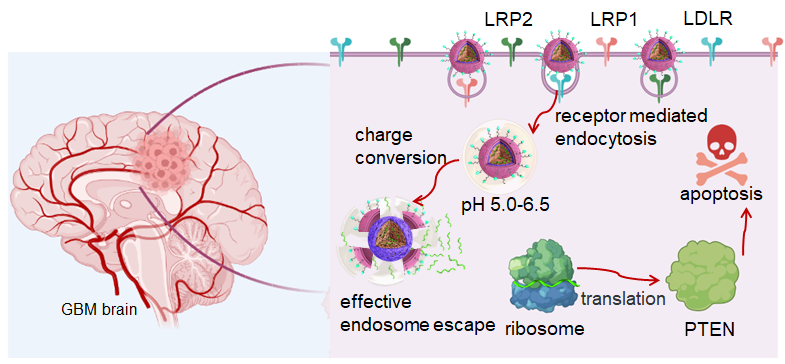Abstract
Messenger RNA (mRNA) based gene therapy holds great promise for treating various brain-related disorders including brain cancer. However, mRNA instability, inability to pass the blood-brain barrier (BBB) and lack of tumour targeting, hindering the further application of mRNA in brain disease therapy. Here we designed a new mRNA nanomedicine (ABNPs@mRNA) and demonstrated that it could effectively address the above challenges by combining three distinct design strategies: ApoE peptide based “two birds, one stone” targeting, cell membrane based biomimetic cloaking and tumour microenvironment responsive controlled drug release. To effectively target to glioblastoma (GBM), we loaded ABNPs@mRNA with phosphatase and tensin homolog deleted on chromosome 10 (PTEN) mRNA, a tumour suppressor that is mutated or inactive in 20–40% of GBM. Loss of PTEN activity in GBM patients correlates with therapeutic resistance, oncogenesis and poor prognosis. Together, our three design elements enabled ABNPs@mRNA to deliver a maximum PTEN mRNA concentration of 7.22% injection dose (ID)/g in brain tumour tissue. In the orthotopic GBM mouse models (U87MG and patient-derived CSC2 GSCs xenograft), treatment with ABNPs@mRNA resulted in a remarkable extension of median survival time relative to mice receiving PBS (49 d versus 23 d in U87MG and 40 d versus 23 d in CSC2 model). Importantly, ABNPs@mRNA nanomedicine caused negligible side effects in major organs including liver and kidney. Considering the stability, safety, non-invasive brain delivery and GBM inhibition efficacy, our new mRNA nanomedicine may unlock a new avenue for mRNA application in GBM inhibition and beyond.

